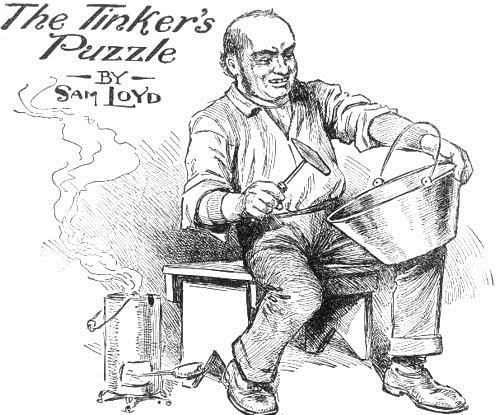



CATERING TO THE mathematical bent of The many who revel in geometrical problems and abstruse calculations I shall take occasion to call attention to that jingling bit of Mother Goose which appears to contain a somewhat pretty problem. The old song says:
“I agreed with a tinker whose name was Doo-little
To make for my aunt a flat-bottomed kettle.
Twelve inches exactly the depth of the same.
And twenty-five gallons of beer to contain.
The inches across at the top would show
Just twice the width, as measured below.
So tell me that width, across at the top.
For auntie now wants a lid from the shop.”
There is nothing required to be added to the above data, so we will just see how many of our mathematicians can give us the diameter of the required lid to fit on the kettle, which is twelve inches deep, and will hold just twenty-five gallons.
Taking 282 cubic inches as a one beer gallon, we have for 25 gallons 7,050 cubic inches. Then, by prismoidal formula for obtaining volume of figures of proportionate ends (sum of areas of two ends plus four times area of middle section parallel to them, multiplied by one-sixth vertical height equals volume), we have 12 inches, the vertical height, divided by 6 equals 2; and 7,050 divided by 2 equals 3,525, which is the combined area of the two ends plus four times the area of the middle section. Now, as the diameter of the top and bottom are as 2 to 1, the diameter of the middle section will be represented by 1 1/2 and areas will be in proportion of 4, 2 1/4 and 1; but as we take four times the area of the middle sections, the proportions, per formula, will be as 4, 9 and 1, or a total of 14, of which the area of the top represents 4/14, and 4/14 of 3,525 equals 1,007 2/14, the area of the top. Then, dividing 1,007 2/14 by .785398163397 and extracting the square root of the quotient to obtain diameter, we get 35.8096—which is the diameter of the top.
2.
Why is a railroad track a particularly sentimental object? Because it is bound by close ties.
What is society composed of? A mixture of mister-ies and miss-eries.
What is taken from you before you get it? Your portrait.
When is a man’s friendship most severely tried? When he stands a loan.
What melancholy fact is there about a calendar? There is no time when its days are not numbered.
What is the best food for dyspeptic people? Oysters; because they die-just (digest) before they are eaten.
Why is a distanced horse like a man in a shady place? Because he is out of the heat.
Do you know what is the oldest piece of furniture in the world? The multiplication table.
Why is a kiss like a rumor? Because it goes from mouth to mouth.
When are soldiers best able to draw blisters? When they are mustered in the service.
Why is the woodsman's ax an inconsistent weapon? Because it cuts a tree down and then cuts it up.
Why is an inn-keeper like a multitude of people? Because he is a host himself.
Why is the blush of modesty like a little girl? Because it becomes a woman.
Why is a bad epigram like a useless pencil? Because it has no point.
If you see a counterfeit coin on the street why should you always pick it up? Because you may be arrested for passing it.
What key opens the door to the penitentiary? Whis-key.
Why is a pig with a curly continuation like the ghost of Hamtlet’s father? Because he could a tail unfold.
Why is a plowed field like feathered game? Because it’s part-ridges.
How would you make a tall man short? Borrow money of him.
[Page 149]